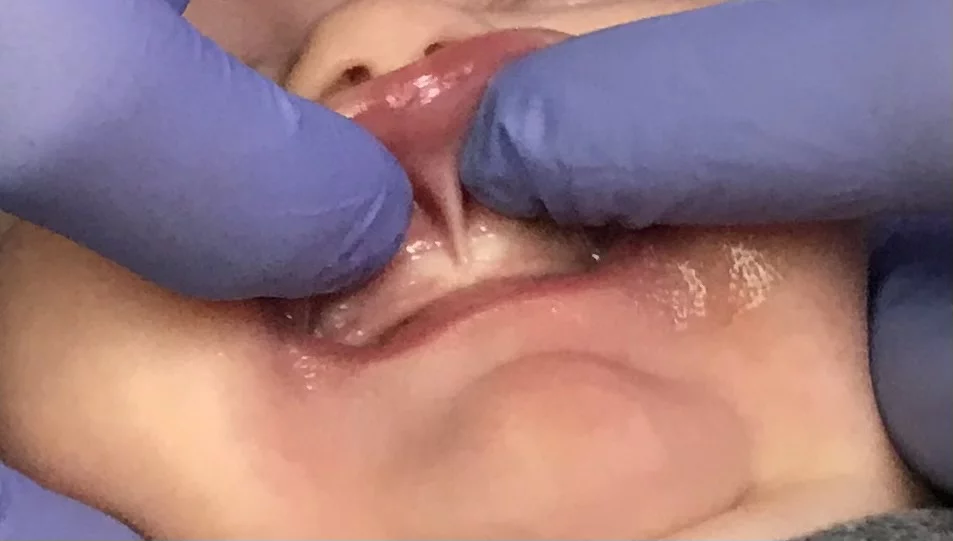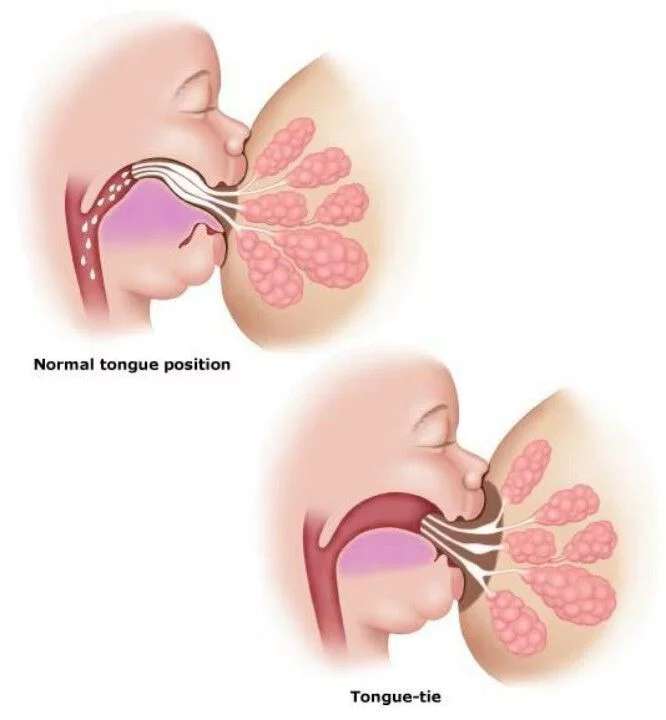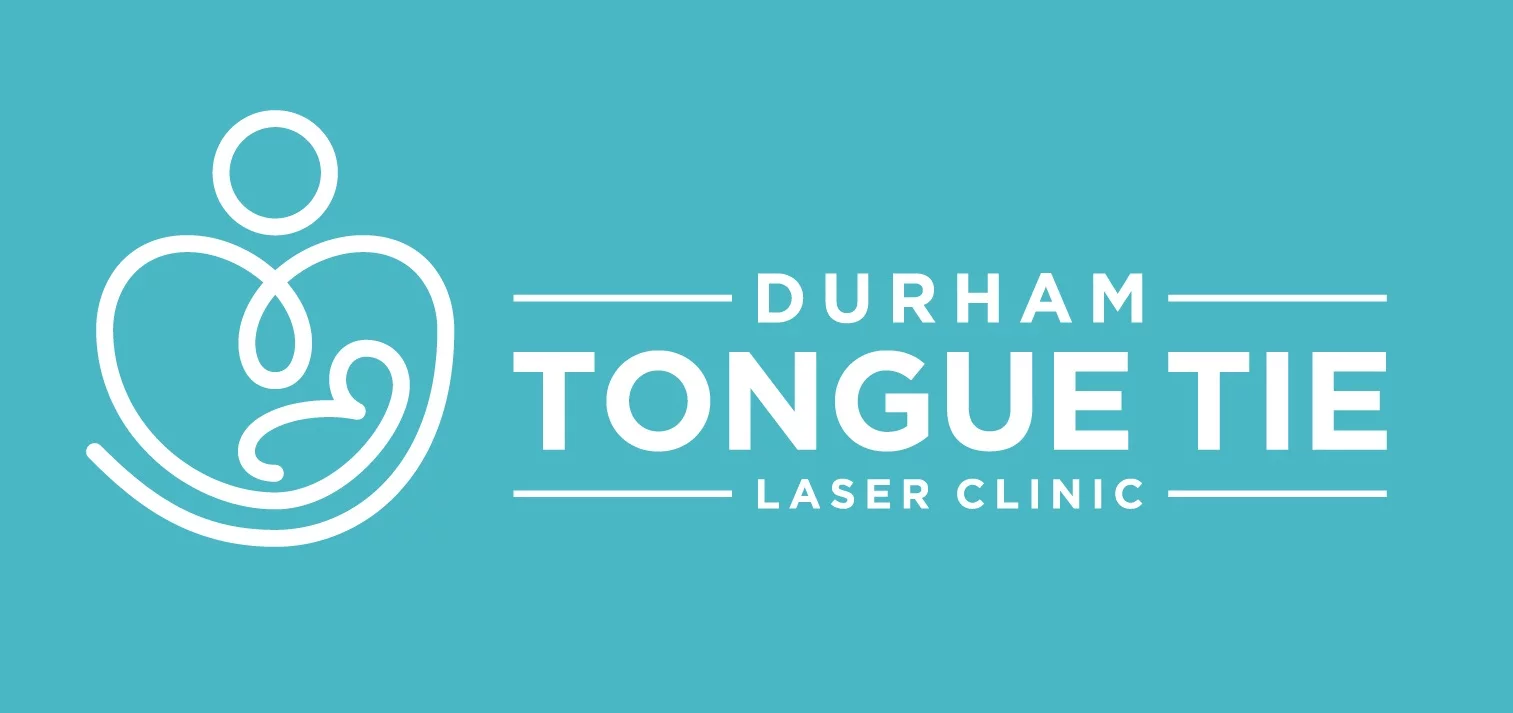Procedures
Tongue Tie Release
What is a tongue-tie?
A tongue-tie is a band of muscular tissue that prevents the tongue from moving freely in a way that makes normal nursing, eating or speaking possible. Tongue ties can either be an anterior tongue-tie or a posterior tongue-tie. An anterior tongue tie is typically one that is very obvious to notice in an infant’s mouth as a thin band of tissue visible when the tongue is lifted. A posterior tie is one that is deep below the oral mucosa and must be diagnosed and exposed by a trained professional. The frustration with posterior tongue ties is that they are not as obvious, so they are often missed at the birth check or by other practitioners and are only diagnosed if there is ongoing difficulty with nursing. Symptoms of both anterior and posterior tongue-ties are often identical and both can be successfully treated with a tongue tie release (also called a frenectomy).
Why may a release be necessary?
The tongue is essential for successful nursing. It is used to make a seal with the hard palate and simultaneously covers the lower gums during feeding. If the tongue is restricted, the gums are left uncovered, which may contribute to painful nursing for mom. Additionally, the lack of a seal around the nipple can cause a baby to swallow air during nursing and not draw the amount of milk that is possible with a fully functioning tongue. Swallowed air during nursing can lead to a gassy or fussy baby.

Tongue Tie Release
What is a tongue-tie?
A tongue-tie is a band of muscular tissue that prevents the tongue from moving freely in a way that makes normal nursing, eating or speaking possible. Tongue ties can either be an anterior tongue-tie or a posterior tongue-tie. An anterior tongue tie is typically one that is very obvious to notice in an infant’s mouth as a thin band of tissue visible when the tongue is lifted. A posterior tie is one that is deep below the oral mucosa and must be diagnosed and exposed by a trained professional. The frustration with posterior tongue ties is that they are not as obvious, so they are often missed at the birth check or by other practitioners and are only diagnosed if there is ongoing difficulty with nursing. Symptoms of both anterior and posterior tongue-ties are often identical and both can be successfully treated with a tongue tie release (also called a frenectomy).
Why may a release be necessary?
The tongue is essential for successful nursing. It is used to make a seal with the hard palate and simultaneously covers the lower gums during feeding. If the tongue is restricted, the gums are left uncovered, which may contribute to painful nursing for mom. Additionally, the lack of a seal around the nipple can cause a baby to swallow air during nursing and not draw the amount of milk that is possible with a fully functioning tongue. Swallowed air during nursing can lead to a gassy or fussy baby.
Lip Tie Release
What is a lip tie?
A lip tie is when the upper or lower lip is restricted by a band of muscle that attaches it to the gums. A lip tie release is the removal of this band of tissue that is preventing the lip from moving in the desired and necessary way. More commonly it is the upper lip that is restricted. However, the lower lip may also be contributing to nursing challenges.
Why may a release be necessary?
In ideal nursing, the upper lip flares upward and the lower lip flares downward, creating a seal for nursing. If you see the lips tucking inward toward the mouth, the tissues may be restricted.

Lip Tie Release
What is a lip tie?
A lip tie is when the upper or lower lip is restricted by a band of muscle that attaches it to the gums. A lip tie release is the removal of this band of tissue that is preventing the lip from moving in the desired and necessary way. More commonly it is the upper lip that is restricted. However, the lower lip may also be contributing to nursing challenges.
Why may a release be necessary?
In ideal nursing, the upper lip flares upward and the lower lip flares downward, creating a seal for nursing. If you see the lips tucking inward toward the mouth, the tissues may be restricted.
Your Visit
At Durham Tongue Tie Laser Clinic we believe in a team approach to treating tethered oral tissues. During the appointment, you will first meet with a Lactation Consultant (LC). Regardless of whether or not your infant is breast/chestfed, the LC has the training and expertise to assess and diagnose tongue and lip ties and their possible impact.
During your time with the LC, they will:
- Take a detailed nursing history
- Perform a basic physical exam of your child
- Listen to your observations and concerns
- Assess and/or diagnose the presence of a Lip and/or Tongue Tie
- Create a care plan with the input of Dr. Robert (this may include the recommendation of bodywork)
- Review post-op care, stretches and a follow-up plan

Your Visit
At Durham Tongue Tie Laser Clinic we believe in a team approach to treating tethered oral tissues. During the appointment, you will first meet with a Lactation Consultant (LC). Regardless of whether or not your infant is breast/chestfed, the LC has the training and expertise to assess and diagnose tongue and lip ties and their possible impact.
During your time with the LC, they will:
- Take a detailed nursing history
- Perform a basic physical exam of your child
- Listen to your observations and concerns
- Assess and/or diagnose the presence of a Lip and/or Tongue Tie
- Create a care plan with the input of Dr. Robert (this may include the recommendation of bodywork)
- Review post-op care, stretches and a follow-up plan
Our Procedural Approach
For both tongue and lip tie releases, your infant will be swaddled and either laid on a changing board or seated in a dental assistant’s lap. A small amount of Emla topical cream is applied to the surgical site and allowed to gently numb the area. We use an Erbium YAG laser to ablate the tissues, thereby releasing the ties. The precision of our laser allows us to remove only 5 micrometers of tissue at a time, in a very controlled and accurate manner. The laser we use is nothing like a light sabre or Austin Powers style laser! Our laser works at precisely 100 degrees Celsius, which is much lower than other commonly used lasers that can reach 900 degrees Celsius. The precise action of the Erbium laser allows for gradual and controlled release, for a consistent and desirable outcome.
Using an Erbium YAG laser, there is considerably less bleeding than from tongue and lip tie releases with scissors or scalpel. Also, there is likely less pain. Due to regulations, only trained personnel and the patient are permitted in the operatory during the procedure. For this reason, after the examination and discussion of findings, we kindly ask that parents remain in the waiting room during the procedure. The procedure itself takes less than 2 minutes, but due to preparation, you may be waiting for 5-10 minutes. Typically, the baby is upset during the procedure, due to the overwhelming nature of having intra-oral surgery, but most babies are happy and relaxed within 5 minutes of finishing. Following the procedure, we encourage attempting to breast/chest feed in our clinic, with areas for privacy provided. Our lactation consultant and Dr. Robert are available to answer any questions after the procedure. For older children, conventional freezing with a needle may be indicated and the use of nitrous oxide may be recommended to ensure a smooth and pain-free experience.

Our Procedural Approach
For both tongue and lip tie releases, your infant will be swaddled and either laid on a changing board or seated in a dental assistant’s lap. A small amount of Emla topical cream is applied to the surgical site and allowed to gently numb the area. We use an Erbium YAG laser to ablate the tissues, thereby releasing the ties. The precision of our laser allows us to remove only 5 micrometers of tissue at a time, in a very controlled and accurate manner. The laser we use is nothing like a light sabre or Austin Powers style laser! Our laser works at precisely 100 degrees Celsius, which is much lower than other commonly used lasers that can reach 900 degrees Celsius. The precise action of the Erbium laser allows for gradual and controlled release, for a consistent and desirable outcome.
Using an Erbium YAG laser, there is considerably less bleeding than from tongue and lip tie releases with scissors or scalpel. Also, there is likely less pain. Due to regulations, only trained personnel and the patient are permitted in the operatory during the procedure. For this reason, after the examination and discussion of findings, we kindly ask that parents remain in the waiting room during the procedure. The procedure itself takes less than 2 minutes, but due to preparation, you may be waiting for 5-10 minutes. Typically, the baby is upset during the procedure, due to the overwhelming nature of having intra-oral surgery, but most babies are happy and relaxed within 5 minutes of finishing. Following the procedure, we encourage attempting to breast/chest feed in our clinic, with areas for privacy provided. Our lactation consultant and Dr. Robert are available to answer any questions after the procedure. For older children, conventional freezing with a needle may be indicated and the use of nitrous oxide may be recommended to ensure a smooth and pain-free experience.
Post-Operative Care
Following the procedure, stretches of each surgical site are strongly recommended for an ideal outcome. These stretches will be demonstrated prior to the surgery and you are welcome to record them for future reference or refer to our Patient Resource tab for further instruction. These stretches are recommended in order to prevent the tissues from healing in the same place and having no improvement from surgery.

Post-Operative Care
Following the procedure, stretches of each surgical site are strongly recommended for an ideal outcome. These stretches will be demonstrated prior to the surgery and you are welcome to record them for future reference or refer to our Patient Resource tab for further instruction. These stretches are recommended in order to prevent the tissues from healing in the same place and having no improvement from surgery.
Children and Adults
We treat adults and children over the age of 6 as well. Many people suffer with speech, eating, sleep, and body tension issues that are related to tongue ties. For best results, we work alongside Oral Myofunctional Therapists(OMTs) in order to optimise results. The pre-surgical exercises provided by the OMTs ensure that the muscles and fascia of the tongue are prepared for the release. The post-surgical appointments and exercises with the OMT also increase the ideal healing of the tongue and/or lip.
Reach out to us for a referral and a questionnaire that will indicate if a release may be beneficial to you.

Children and Adults
We treat adults and children over the age of 6 as well. Many people suffer with speech, eating, sleep, and body tension issues that are related to tongue ties. For best results, we work alongside Oral Myofunctional Therapists(OMTs) in order to optimise results. The pre-surgical exercises provided by the OMTs ensure that the muscles and fascia of the tongue are prepared for the release. The post-surgical appointments and exercises with the OMT also increase the ideal healing of the tongue and/or lip.
Reach out to us for a referral and a questionnaire that will indicate if a release may be beneficial to you.
